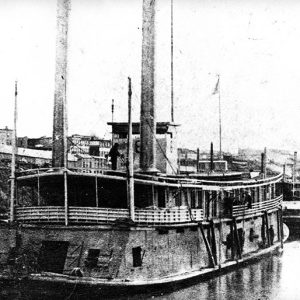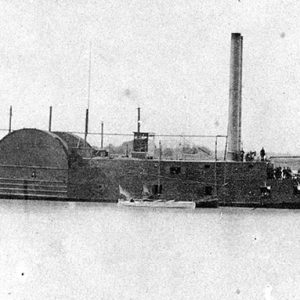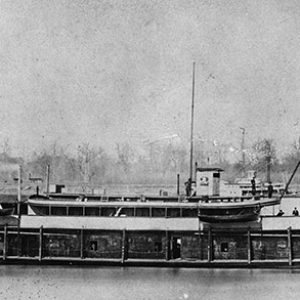calsfoundation@cals.org
Engagement at West Point
aka: Little Red River Raid
| Location: | White County |
| Campaign: | Expedition up the White and Little Red Rivers |
| Date: | August 14, 1863 |
| Principal Commanders: | Lieutenant Colonel Gustavas A. Eberhardt, Lieutenant George M. Bache, Lieutenant Amos R. Langthorne (US); Colonel Gideon W. Thompson, Lieutenant Colonel Charles A. Gilkey (CS) |
| Forces Engaged: | Thirty-second Iowa Infantry (US); Shelby’s Iron Brigade (CS) |
| Casualties: | 2 killed, 6 or 7 wounded (US); 1 killed, 6 or 7 wounded (CS) |
| Result: | Union victory |
The Confederacy suffered a crushing defeat on July 4, 1863, following an unsuccessful assault on the Union garrison at Helena (Phillips County), which was intended to relieve pressure on besieged Vicksburg, Mississippi. Vicksburg surrendered on July 4, and the defeat at Helena—coupled with Confederate surrender at Port Hudson, Louisiana, on July 9—severed Arkansas, Texas, and western Louisiana from the rest of the Confederate states. Major General Sterling Price was formally tasked with the defense of Arkansas on July 23, but increasing desertions within the Rebel ranks thinned the already meager forces available to resist the imminent Union push to capture Little Rock (Pulaski County).
The Little Rock Campaign involved the movement of two Union columns: a division led by Brigadier General John Davidson moving down Crowley’s Ridge from Missouri, and another from Helena led by Major General Frederick Steele. The two columns were to rendezvous before marching west toward the capital. A cavalry division commanded by Major General John Marmaduke at Jacksonport (Jackson County) was the only Confederate force that could oppose Davidson’s southward advance, and Marmaduke was encouraged by Price to observe and impede Davidson’s progress. Marmaduke instead opted to move south and camp near Searcy (White County) to avoid being cut off from other Confederate units in central Arkansas. Davidson had apparently anticipated this movement and halted his march upon reaching Clarendon (Monroe County), where he awaited the arrival of Steele’s infantry.
Four days after Davidson’s arrival in Clarendon, the gunboats Cricket, Marmora, and Lexington, along with a detachment from the Thirty-second Iowa, were dispatched up the White River toward Jacksonport to determine the whereabouts of Marmaduke’s cavalry and capture the Kaskaskia and Tom Sugg, two Confederate steamboats in use on the river. Early on August 13, the flotilla set out, pausing at Des Arc (Prairie County), where the Union force gathered intelligence, burned a warehouse containing corn meal, and destroyed local telegraph lines. The flotilla divided on the morning of August 14 upon reaching the confluence of the Little Red River with the White River. Lieutenant George Bache, captain of the Lexington, believed the Confederate steamboats to be farther up the Little Red and sent the Cricket in that direction, commanded by Lieutenant A. R. Langthorne. The Marmora and Lexington continued north and disembarked at Augusta (Woodruff County) but found no Rebels nearby and returned to the mouth of the Little Red. The Cricket had not returned by this time, so the Lexington headed upriver in pursuit.
The Cricket, meanwhile, discovered the Kaskaskia and Thomas Sugg on the Little Red at Searcy, as well as a pontoon bridge being used by Marmaduke to cross his cavalry. The two steamboats were captured, apparently without incident, and the infantry confiscated several bales of cotton after burning the pontoon bridge, leaving some of Marmaduke’s division stranded on the east side of the Little Red. The Union men prudently used the cotton bales to construct bullet-resistant breastworks aboard the ships in anticipation of a Confederate reprisal on the return trip down the river.
Confederate pickets along the Little Red were alerted by the passage of the Cricket, and a contingent of Shelby’s Iron Brigade, then commanded by Colonel Gideon Thompson, hastily planned an assault to retake the boats during its return trip. About 500 cavalrymen took position on a high bank at a bend along the Little Red at West Point (White County), which anticipated support by a battery of artillery that did not arrive in time for the battle. A lead regiment commanded by Lieutenant Colonel Charles Gilkey rushed to the riverbank as the boats passed and opened fire.
The ensuing battle was furious and lasted about twenty minutes, with infantry on the boats and cavalry on the shore firing at a distance of about thirty yards. The pilot of the Kaskaskia was wounded twice before being incapacitated; the ship floundered, but the Cricket did manage to get the Kaskaskia back under tow before it could be boarded. Regarding this part of the battle, a Sergeant Boyd of the Thirty-second Iowa wrote, “the stream being very narrow, the limbs on both sides would brush the boats and swing them against the bank, and the enemy [was] only prevented from boarding [the Kaskaskia] at the point of the bayonet.” Boyd also credited the cotton breastworks with their invaluable protection during the firefight. Union forces sustained two killed, at least six (possibly seven) wounded; the Confederates suffered seven or eight men wounded, including a mortally wounded Col. Gilkey. The Confederates fell back, and the Cricket, with its prizes in tow, continued down the river. By the time some remnants of the Iron Brigade managed to intercept the Cricket a second time, it had already united with the Lexington; salvos from both gunboats quickly dispersed the remaining Confederates.
The flotilla arrived back in Clarendon on August 15 with the Kaskaskia and Thomas Sugg in tow, and Gen. Davidson reportedly was “tickled wonderfully at the unexpected success of the expedition.” Lt. Bache in particular noted the excellent condition of the captured steamboats and their potential for future use along local rivers. Intelligence gathered during the expedition also confirmed that Marmaduke was moving his division south to join Price’s defensive line northeast of Little Rock.
For additional information:
Christ, Mark K. Civil War Arkansas, 1863: The Battle for A State. Norman: University of Oklahoma Press, 2010.
Key, Ellen. “The West Point Cannon Ball.” White County Heritage 7 (January 1969): 43–44.
Muncy, Raymond Lee. Searcy, Arkansas: A Frontier Town Grows Up With America. Searcy, AR: Harding Press, 1976.
Ross, Margaret. “Single Shot Captures Confederate Transports, 1863.” White County Heritage 1 (October 1963): 8.
The War of the Rebellion: A Compilation of the Official Records of the Union and Confederate Armies. Series 1, Vol. 22, Part I, Washington DC: Government Printing Office, 1888.
The War of the Rebellion: A Compilation of the Official Records of the Union and Confederate Armies. Series 1, Vol. 41. Washington DC: Government Printing Office, 1893.
Watson, Lady Elizabeth. Fight and Survive! A History of Jackson County, Arkansas in the Civil War. Conway, AR: River Road Press, 1974.
Adam Miller
Searcy, Arkansas
 Civil War Timeline
Civil War Timeline Military
Military ACWSC Logo
ACWSC Logo  USS Cricket
USS Cricket  USS Lexington
USS Lexington  USS Marmora
USS Marmora  West Point Memorial
West Point Memorial 




Comments
No comments on this entry yet.